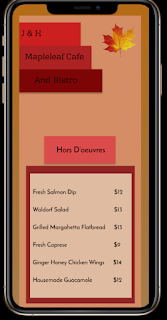Screen Menu for IPhone

This progress is an extension to the print menu that is displayed as a UX based project in my portfolio. I utilized the same aesthetic and approach for this concept restaurant and created an app prototype in Figma for it. This responsive design allows for seamless menu viewing in an interface rather than a graphic design. Color palettes were consistent along with logo creation, and Adobe tools were used to create a digital experience for users that provides more information about what the Mapleleaf Cafe and Bistro actually is! Screen Menu in Figma: Draft 1: Draft 2: Final Draft: Reflecting back on this project, I can say that I really do enjoy creating interface layouts that combine creative design with responsive interactivity. The conceptual and endless creativity that comes with the thought processes of a creative technologist really makes me proud to be included in this body of work. I really wish to devote my career to building creative branding for a company that suits those desi...




